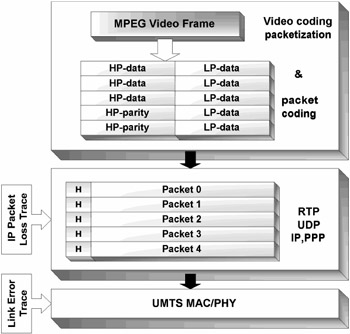5.7 Integrating the Adaptation for Streaming Video over Wireless Networks
5.7 Integrating the Adaptation for Streaming Video over Wireless Networks
UDP is generally used for video streaming; however, it is unable to distinguish between packet losses caused by network congestion and by channel errors. For this reason, it is more appropriate to use UDP over wireline networks than over wireless networks. UDP-Lite, on the other hand, ignores channel errors unless they corrupt a packet header. By doing so, it shifts the error-handling responsibility to the application. When packet-level FER coding is deployed to provide error control, CUDP is superior to UDP-Lite because CUDP utilizes error indication from the link layer. In general, the transmission unit at the link layer is smaller than that at the network and transport layers, so that link layer error indications provide a precise estimation of the error location. In general, a (n,k) FEC code can recover any (n-k)/2 errors or (n-k) erasures per n data units. A packet FEC decoder can use the error locations to group erroneous data blocks to erasures and double the error recovery capability. Without packet FEC coding, the error indication is still beneficial because it can assist a video decoder to locate errors by formatting the corrupted link layer unit as all "1s."
The performance of UDP, UDP-Lite, and CUDP was compared in Zheng and Boyce [56] in terms of streaming MPEG video through a UMTS-similar system. The simulation flow chart is shown in Figure 5.4, where an MPEG video sequence of QSIF format (176 120 pixels) was coded at a bit rate of 288 kbps and a frame rate of 24 fps. The HiPP method [57] was used to provide packet FEC coding with an overhead of 25 percent, yielding a total source rate of 384 kbps. In particular, the MPEG video was split into two partitions with different priorities, HP and LP. The HP data contain more-important information. Video can be decoded with reduced quality, by using only the HP data. In regard to the trade-off between overhead and resilience, only the HP data was protected with an FEC coding by application server. Experimental IP packet loss traces and simulated wireless error traces [58] were applied to the packet flow. Transport packets were segmented to IP packets of 800 bytes and experimental IP packet loss traces were applied at the network layer. Link layer provides up to 384-kbps connections, and data units are 90 bytes each. The effect of link layer retransmissions and MAC layer scheduling is embedded in the error traces.

Figure 5.4: Simulation flow chart.
Figure 5.5 depicts video performance in terms of the averaged PSNR, where CUDP achieves 2 to 6 dB of PSNR improvement over UDP, and 5 to 10 dB over UDP-Lite. As congestion packet loss increases, the advantages diminish because network congestion becomes the dominant impairment.

Figure 5.5: Video PSNR for UDP, UDP lite and CUDP.
Please note that the overall performance can be further enhanced by adjusting packet coding redundancy as well as source rate according to channel condition which has been extensively studied in Girod and coworkers, [59], [60] Liu and Zarki, [61] Aramvith and coworkers, [62] Hsu and coworkers, [63] Chan et al., [64] and Zhang and coworkers. [65],[66],[67],[68],[69],[70],[71],[72]
[56]Zheng, H. and Boyce, J., An improved UDP protocol for video transmission over Internet-to-wireless networks, IEEE Trans. Multimedia, 3 (3), 356–364, 2001.
[57]Boyce, J., Packet loss resilient transmission of MPEG video over the Internet, Signal Processing: Image Communication, pp. 7–24, September 1999.
[58]Foschini, G.J., Layered space-time architecture for wireless communication in a fading environment when using multiple antennas, Bell Labs Tech. J., 1 (2), 41–59, 1996.
[59]Girod, B. and F rber, N., Wireless Video, in Compressed Video Over Network, Reibman, A.and Sun, M.T., Eds., Marcel Dekker, New York, 2000.
[60]Girod, B. et al., Advances in channel adaptive video streaming, Proc. IEEE International Conference on Image Processing (ICIP 2002), Rochester, September 2002.
[61]Liu H. and Zarki, M.E., Adaptive source rate control for real-time wireless video transmission, Mobile Networks Appl., 3, 49–60, 1998.
[62]Aramvith, S., Pao, I.-M., and Sun, M.-T., A rate-control scheme for video transport over wireless channels, IEEE Trans. Circuits Syst. Video Technol., 11, 569–580, 2001.
[63]Hsu, C.Y., Ortega, A., and Khansari, M., Rate control for robust video transmission over burst error wireless channels, IEEE J. Selected Areas Commun., 17 (5), 756–773, 1999.
[64]Chan, C.W. et al., Eds., Special issue on error resilient image and video transmissions, IEEE J. Selected Areas Commun., 18 (6), 2001.
[65]Zhang, Q., Zhu, W., and Zhang, Y.Q., Network-adaptive rate control and unequal loss protection with TCP-friendly protocol for scalable video over Internet, J. VLSI Signal Process.: Syst. Signal, Image Video Technol., 2001.
[66]Sun, M. and Reibman, A., <II>Compressed Video over Networks,</II> Marcel Dekker, New York, September 2000.
[67]Wiegand, T., ISO/IEC 14496-10: 2002, Joint Committee Draft, May 2002.
[68]Larzon, L., Degermark, M., and Pink, S., UDP lite for real time multimedia applications, Proc. QoS Mini-Conference, IEEE International Conference of Communications (ICC '99), Vancouver, Canada, June 1999.
[69]Budge, D. et al., Media-independent error correction using RTP, Internet Engineering Task Force, Internet Draft, May 1997.
[70]Wenger S. and C t , G., Using RFC2429 and H.263+ at low to medium bit-rates for low-latency applications, Packet Video '99, New York, April 1999.
[71]Gallant, M. and Kossentini, F., Robust and efficient layered H.263 Internet video based on rate-distortion optimized joint source/channel coding, Packet Video '00, Italy, 2000.
[72]Wenger, S. and C t , G., Test model extension justification for Internet/H.323 video transmission, Document Q15-G-17, ITU Q15, Video Coding Experts Group, February 1999.
EAN: 2147483647
Pages: 239